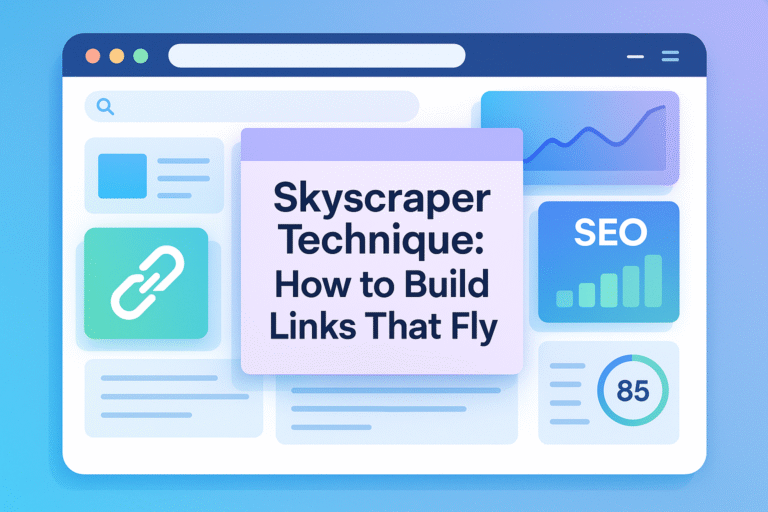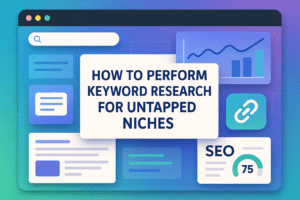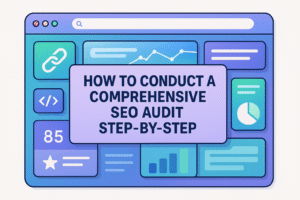In the ever-evolving landscape of digital marketing, mastering the art of optimizing site structure for maximum crawlability has become crucial for anyone aiming to enhance their website’s visibility. A well-structured site not only improves user experience but also ensures that search engines can effectively crawl and index your pages. This article delves into the importance of site structure in SEO, highlighting the numerous benefits of optimizing it for better crawlability. You will gain insights into the fundamental concepts of site structure and crawlability, and discover best practices that can help you streamline your website for optimal performance in search engine results.
Understanding Website Architecture SEO: The Foundation of Crawlable Design
Importance of Website Architecture in SEO
Website architecture refers to the structured organization of a site’s pages and content, and serves as a foundational element for site structure SEO. Good architecture improves site crawlability, a critical aspect that search engines like Google consider when crawling and indexing your site. Their automated crawlers, often called “spiders” or “bots,” navigate websites through this structural framework to discover new and updated pages. Thus, a well-thought-out website architecture can significantly enhance a site’s crawlable design, ensuring that search engines can efficiently index all essential pages, thereby boosting search engine rankings.
Key SEO Benefits of Strong Site Structure
A sound website structure offers several key SEO benefits. First and foremost, it ensures enhanced site crawlability, allowing search engine bots to easily discover and prioritize your content. By strategically organizing pages in a hierarchical manner, with a logical flow from main categories to subcategories, link authority flows more seamlessly throughout the site, granting more weight to important pages. This method not only boosts organic ranking potential but also contributes to a better user experience, as visitors can navigate the site effortlessly. Improved navigation typically reduces bounce rates, keeping users engaged longer and signaling to search engines that the site provides valuable content.
The Role of Internal Linking and Sitemaps
Internally linking related pages as part of a coherent internal linking strategy further strengthens crawlability. By using descriptive anchor texts, you guide both users and spiders along the intended paths, distributing authority and relevance through the site. Complementing this strategy with an XML sitemap enhances accessibility by outlining the site’s structure to search engines, ensuring all relevant pages are indexed accurately. Both of these elements play pivotal roles in constructing a crawlable website design that supports an SEO silo structure, thereby aligning with best practices in site structure SEO.
In sum, by focusing on optimizing site structure through thoughtful website architecture SEO, you ensure that search engine crawlers can efficiently explore and index your website, ultimately boosting its visibility and performance across search engines.
The Role of Internal Linking Strategy in Optimizing Site Structure
Establishing Hierarchy with Internal Links
An effective internal linking strategy is pivotal in optimizing site structure by establishing a clear hierarchy. This system guides search engines and users through the labyrinth of your website’s architecture. By strategically linking pages, you offer search engines a road map to follow, helping them understand the relationships between pages and prioritize which to crawl and index first. Interestingly, this method aids in highlighting the most important “cornerstone” content within a site, ensuring these pages receive adequate attention from search engines. Furthermore, internal links allow the distribution of link equity, thereby transferring authority from highly ranked pages to others—an essential aspect of technical SEO that enhances overall site performance.
Regular Site Audits and SEO Enhancement
Conducting regular site audits is crucial for maintaining a healthy internal linking profile. These audits help identify broken links, orphaned pages, and opportunities for connecting related content. By leveraging tools like SEMrush and Ahrefs, you can streamline this process, gaining insights into potential improvements within your site architecture. Regular analysis ensures that crucial pages remain accessible and relevant, directly benefiting your technical SEO efforts. This proactive approach not only bolsters your site’s performance in search engine rankings but positively impacts user engagement metrics by providing a seamless navigation experience.
Improving User Experience
Optimized internal linking contributes significantly to user experience by simplifying website navigation and guiding users to relevant content. Implementing a logical linking strategy encourages visitors to spend more time on your site, reducing bounce rates and increasing pages per session. Internal links, when used effectively, can create natural paths for users that correlate with their journey towards conversion points. For example, linking product categories and related articles within e-commerce websites can intuitively lead users to purchase decisions. This integration of internal linking into your SEO silo structure is beneficial in creating a crawlable website design that enhances both user satisfaction and search engine optimization outcomes.
SEO Silo Structure: Organizing Your Content for Maximum Impact
Understanding SEO Silo Structure
An SEO silo structure is a strategic way of organizing a website’s content into distinct, thematic categories or “silos.” This method not only enhances user experience by making navigation more intuitive but also significantly boosts search engine optimization. By sorting content into clear silos, search engines can more efficiently crawl and index the site, thereby improving the overall crawlability and ranking potential.
Benefits of Content Silos
The primary advantage of an SEO silo structure is its ability to create clear thematic groupings. These groupings deliver a coherent message to search engines and signal the relevance of content within each silo. This reinforcement optimizes website architecture SEO by increasing topical authority and link equity distribution. Users benefit too, as content silos lead them through a logical path, enhancing navigation and content discoverability. By decorating each silo with robust internal linking, you ensure that both search engines and users find it easier to explore related content, making your site a beacon of contextual richness.
Implementing Silos in SEO
To construct an effective SEO silo structure, begin by conducting comprehensive keyword research to pinpoint core topics and subtopics as outlined by Ahrefs. Next, develop main categories or silos corresponding to these topics and ensure that each silo includes a “pillar” or “hub” page. This pillar acts as the anchor, linking to all supporting pages within its silo. It is crucial to avoid inter-silo linking as it blurs thematic boundaries and may hinder PageRank flow across the website.
In practice, a streamlined URL pattern reflecting the silo architecture can guide crawlers effortlessly through the site map and can make it easier for users to trace their path. Each internal link acts as a tunnel directing both crawlers and users to new destinations while maintaining thematic integrity, enhancing your site’s crawlable website design.
By effectively leveraging SEO silos, you create an organized, crawlable website design that not only supports your site’s SEO strategy but also elevates the user experience.
Crafting a Crawlable Website Design: Tips and Techniques
Enhancing Internal Linking for Better Crawlability
Optimizing your internal linking strategy is a crucial step in creating an efficient, crawlable website design. By linking related content within your site, you create a roadmap that guides search engine bots, such as Googlebot, through your site’s architecture. This approach not only aids in distributing link equity across your pages but also improves navigation for users, enhancing both user experience and crawlability. Using descriptive_anchor texts_, rather than generic labels like “click here,” ensures that both users and search engines understand the context of each link more clearly.
Leveraging Sitemaps for Improved Crawlability
A well-structured XML sitemap serves as a comprehensive map of your website, highlighting the main pages you want search engines to index. By submitting a sitemap to search engines, you help facilitators like Google to discover all of your site’s valuable content more efficiently. It’s essential, however, to keep your sitemap up-to-date, reflecting any changes or additions to your site. Consistent updates ensure that search engine crawlers have access to the latest content, enhancing both discovery and indexability of your site.
Boosting Website Speed and Mobile Responsiveness
Website performance, especially page load speed, is a significant factor in optimizing your site’s crawlability. Fast-loading sites are favored by search engines because they offer better user experiences, a crucial aspect of website architecture SEO. Implementing strategies such as minifying CSS, JavaScript, and images can significantly reduce page load times. Similarly, ensuring your website is mobile-friendly is imperative since mobile-first indexing is the norm. A responsive design that adapts seamlessly across devices not only enhances user interactions but also ensures that your site remains accessible and efficient for search engine crawlers to traverse. These optimizations underscore the importance of maintaining a crawlable website design that promotes your site’s visibility in search results as emphasized by technical SEO practices.
Site Structure SEO Best Practices: From URLs to Navigation
Crafting an SEO-Friendly URL Structure
A well-structured URL enhances your website’s navigation and is pivotal in boosting SEO performance. Opt for simple, clear URLs that reflect the content of the page. Ideally, your URLs should be short and include relevant keywords, making them both user-friendly and appealing to search engines. For instance, instead of using complex dynamic URLs with excessive parameters, choose descriptive words separated by hyphens to improve readability and indexation, a recommendation backed by Google’s guidelines. Such SEO-friendly URLs help convey the page’s purpose and relevance efficiently, aiding both user experience and search engine crawling.
Logical Navigation Structures
Designing an intuitive navigation path is essential for both users and search engines. By organizing content into logical hierarchies with main categories and subcategories, you create a navigable roadmap that guides visitors seamlessly through your site. Clear and descriptive navigation menus are crucial, ensuring that users can find what they’re looking for in just a few clicks. This practice not only enhances user engagement but also solidifies your website architecture SEO by sending positive signals to search engines about the importance and relationships of pages within your site. Victorious emphasizes that well-designed navigation is key to establishing contextual relationships and facilitating efficient page discovery.
Importance of Internal Linking
An effective internal linking strategy is a cornerstone of optimizing site structure. It systematically connects related pages, distributing link equity and enhancing the visibility of crucial content. Use descriptive anchor texts to clarify the linked content’s subject, which assists users and search engines alike in contextual understanding. Internal links also enable search engines to efficiently crawl the website, thus improving its crawlability. SEMrush highlights how these links pass authority throughout the site, emphasizing the need to avoid orphan pages, which are pages with no internal links.
In summary, focusing on creating a clean URL, logical navigation, and robust internal linking strategy not only optimizes your site structure SEO but also enhances overall website performance.
Tools and Techniques for Analyzing Your Website’s Crawlability
In the ever-evolving landscape of search engine optimization, maintaining optimal crawlability of your website is crucial. Fortunately, there are several powerful tools capable of dissecting and enhancing crawlability and indexability.
Moz Pro Site Crawl
Moz Pro Site Crawl monitors your website’s crawlability over time, offering insights into technical SEO issues that may hinder accessibility to your web pages. By regularly analyzing the data provided, you can identify and mitigate problems such as broken links, duplicate content, and other technical barriers. The tool’s ability to provide actionable insights aids in maintaining a healthy, crawlable website, ensuring your content remains visible to search engines.
SEMrush Site Audit
SEMrush’s Site Audit tool is another essential resource for identifying technical issues affecting your website’s crawlability and indexability. This comprehensive tool scans your website to uncover a variety of potential problems, including errors in HTTP status codes, broken links, and other technical barriers. By using SEMrush, you ensure that your site structure aligns with SEO best practices, promoting a more crawlable website architecture.
Screaming Frog SEO Spider
Screaming Frog SEO Spider operates as a desktop program that audits your website for common SEO issues, directly impacting onsite SEO. Capable of analyzing both small and large websites efficiently, it identifies elements like broken links, duplicate content, and redirect chains, giving you a detailed overview of your website’s crawlability. Implementing the insights from Screaming Frog can lead to a more robust internal linking strategy, enhancing your crawlable website design.
These tools, each with unique strengths, should be part of your continual website assessment strategy. Employing them effectively will help you maintain an optimized site structure that facilitates better indexing by search engine bots, ensuring your content achieves maximum visibility in search results. By staying proactive and addressing crawlability issues as they arise, you can significantly boost your website architecture SEO and maintain a smooth path for both users and search engines.
Common Pitfalls in Website Architecture SEO to Avoid
The Danger of Poor Internal Linking
Internal linking is the backbone of a well-optimized website architecture, forming connections between your content to ensure that both users and search engines can navigate your site with ease. However, poor internal linking practices can disrupt this flow, resulting in frustrating user experiences and decreased search engine rankings. Not only does this hinder search engine crawling, but it also makes it difficult for search engines to understand the relevance and context of your content. If your website’s internal linking is scattered and lacks clarity, you risk isolating valuable pages and reducing their visibility.
Lack of Logical Structure
A logical internal linking structure is crucial for creating a crawlable website design. Imagine your website as a city with streets and signs that guide people to their destinations. If the roads are winding and the signs confusing, visitors will struggle to find their way. Similarly, without a logical hierarchy, search engines might fail to index key pages, leading to missed opportunities to rank well in search results. Establishing a thoughtful and coherent internal linking strategy can maximize your website’s crawlability and provide a seamless user experience.
Consequences of Poor Website Architecture
A poor website architecture is an obstacle not only for search engines but also for your audience. Sites with deep, intricate structures often see users abandon their journey out of frustration. When essential pages are buried too deep or are inaccessible, it hampers crawlability and diminishes site authority. Websites should ideally adhere to a flat site structure, allowing users to reach any page within three to four clicks from the homepage. This strategy is integral to maintaining fast page load speeds and ensuring search engines can efficiently crawl and index your site as highlighted by Liberty Marketing.
Optimizing your website architecture for SEO requires meticulous attention to detail, creating an environment where both users and search engines can thrive. Implementing robust internal linking and a logical site structure are vital steps for achieving maximum crawlability and enhancing your site’s visibility.
Advanced Strategies for Enhancing Site Structure and Crawlability
Internal Linking to Deep Pages
Strategic internal linking is an essential aspect of creating a crawlable website design, enhancing both user experience and search engine optimization. By linking to deeper pages within your site, you not only boost the discoverability of older or less-frequented content but also distribute link equity efficiently. This practice signals the importance of these pages to search engines, improving site structure SEO best practices. Employ anchor texts that are descriptive and contextually relevant, allowing search engines to better understand the linked content. This enhances site crawlability and assists search engines in categorizing content effectively, ultimately improving your website’s visibility and authority.
Importance of Clean Site Structure
To maximize crawl efficiency, maintaining a clean site structure is crucial. This involves minimizing unnecessary complexities in your site’s hierarchy and ensuring that all pages are logically organized. Proper internal linking strategies help achieve a more streamlined site layout, guiding both visitors and search engines seamlessly from one section to another. A well-maintained site structure enhances indexability and crawlability, allowing search engines to navigate your site without hindrance. This not only aids in ranking but also elevates the user experience, affirming your site’s status as a reliable and authoritative source of information.
Utilizing Advanced Screaming Frog Techniques
For e-commerce managers and web developers aiming to further refine their website architecture SEO, advanced Screaming Frog tactics can be a game-changer. This tool allows you to optimize crawl efficiency by identifying elements within your link structure that may hamper crawlability. With Screaming Frog, you can verify data integrations, identify broken links, and ensure that your XML sitemaps and robots.txt files are correctly configured. Maintaining a frequently updated sitemap and controlling crawler access via a well-configured robots.txt file are fundamental steps that Screaming Frog can assist with, enhancing both the efficiency and the comprehensiveness of your website’s indexing process.
By implementing these advanced strategies, you ensure that search engines not only find your content but comprehend its relevance, significantly optimizing site structure for better crawlability.
Website Architecture SEO FAQs: Your Top Questions Answered
How Do FAQ Pages Boost SEO?
FAQ pages are more than just informative resources. They serve as powerful tools for improving website architecture SEO by boosting visibility in search results. By incorporating relevant keywords into your FAQ content, these pages can attract more organic traffic and improve your website’s crawlability. When optimized effectively, they offer clear answers to common queries, enhancing user experience and reducing bounce rates—key factors that search engines reward. Additionally, implementing structured data like FAQ schema can help your FAQ pages earn rich snippets in search results, further enhancing visibility and click-through rates according to SEO studies.
Practical Tools to Enhance Crawlability
Optimizing your site’s crawlability often involves leveraging technological tools designed for this purpose. Google’s PageSpeed Insights is vital for identifying elements that can boost your site’s performance and search result ranking. This tool offers insights into how swiftly pages load and factors affecting speed, enabling you to make informed improvements. For a more detailed view of how your site appears to search algorithms, Browseo offers a remarkable perspective. This tool allows you to see what search engines interpret regarding your site’s architecture, helping you refine your SEO silo structure as detailed in numerous resources.
FAQs for Specific Industries
Different industries, like architecture firms, can especially benefit from well-structured FAQs. By addressing client queries directly on these pages, you not only improve website architecture SEO but also engage potential clients. FAQs serve as an accessible information hub that improves site architecture, making it easier for search engines to index and understand the content. By setting clear client expectations and streamlining visitor interactions, FAQs ensure your site remains a reliable source of information. This strategy not only strengthens your local SEO plans but also fosters trust and authority within your industry as outlined in detail.
Conclusion
In conclusion, optimizing your site structure for maximum crawlability is not just a technical endeavor but a strategic necessity in today’s digital landscape. By implementing a flat architecture, logical hierarchy, and streamlined URL structure, you pave the way for search engines to efficiently index your content. Enhancing internal linking, maintaining sitemaps, and refining your robots.txt file further ensure that your website remains accessible and competitive. Remember, a well-optimized site structure not only improves search engine visibility but also enhances user experience, ultimately driving more traffic and engagements. As digital landscapes evolve, staying proactive in site optimization is key to sustained success.




